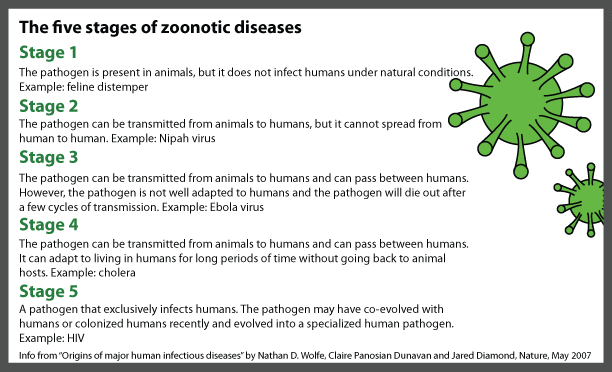Animal Health & Welfare
It is important for pets, zoo animals and farm animals to stay healthy. Animal scientists study how animal housing and feed can affect health. Animal scientists also address welfare concerns in animal production.

It is important for pets, zoo animals and farm animals to stay healthy. Animal scientists study how animal housing and feed can affect health. Animal scientists also address welfare concerns in animal production.
Zoonotic diseases are those spread between animals and people. These diseases are due to a wide range of pathogens including viruses, fungi, parasites, and bacteria. Commonly known zoonotic diseases include: lyme (from ticks) and rabies (from mammals). Zoonotic diseases can cause a wide range of effects in people, and many times even death. Though humans may display evidence of illness, animals do not always appear sick. These animals are commonly referred to as “carriers” as they are carrying disease causing pathogens. Zoonotic diseases are not a new phenomenon. The bubonic plague was a zoonotic disease caused by rodents. Zoonotic diseases continue to be a problem today with recent outbreaks of SARS and H1N1.
Direct contact: This occurs when you are in direct contact with an infected animal’s blood, urine, feces, saliva, or any other bodily fluids. One example is an animal biting or scratching you.
Indirect contact: You are in indirect contact by being in an area animals reside, or touching an object or surface that has been been contaminated by germs. There are many examples of this such as food and water bowls, cages and tanks, as well as plants and soils. This is one of the many reasons it is important to maintain proper hygiene when caring for animals. One should protect themselves, and the animals, by wearing gloves, washing their hands before and after contact, and avoiding eating immediately following cleaning.
Vectorborne: This occurs when you are bitten by a vector. A vector is a organism that both carries and transmits diseases/parasites from one animal/plant to another. For example, a mosquito carrying West Nile Disease biting you.
Foodborne: This is when an individual consumes food/drink that has been contaminated. For example, eating undercooked chicken increases your likelihood of becoming infected with salmonella.
A large concern during the summer months is the Zoonotic disease known as “West Nile Virus”. West Nile Virus is most commonly transmitted through mosquito bites and leads to fever, inflammation of the brain/spinal cord (meningitis) and the brain (encephalitis). There is currently no vaccine available for West Nile Virus, increasing the importance of repellent use. It is recommended that individuals use products containing DEET for longer protection.
It is currently estimated that “More than two new species of human virus are reported every year,” wrote researchers from the University of Edinburgh Centre for Infectious Diseases in a 2008 paper for the Proceedings of the Royal Society B. “Recently discovered viruses are even more likely to be associated with a non-human reservoir.”

Scientists tracking emerging diseases pay close attention to how pathogens are transmitted between individuals. A “Stage 1” pathogen is only passed between animals and does not affect human health. Bluetongue disease is an example of a stage 1 pathogen. After stage 1, epidemiologists get nervous. At stage 2, an animal pathogen can be transmitted from animal to human but does not have the ability to spread from human to human. At stage 3, an animal pathogen can be passed from human to human, but it does not last long in the human population. Ebola is a stage 3 pathogen. Ebola outbreaks originate in the non-human primate population and can cause devastating, but short-lived, outbreaks in human populations. Stage 4 pathogens can be spread from human to human. Stage 4 diseases like yellow fever enter the human population from animals and cause extended outbreaks in humans.
“We do not pay much attention to Stage 1 pathogens until they become stage 2, 3 or 4,” said X. J. Meng, a professor of molecular virology at Virginia Tech.
That lack of attention is a problem if epidemiologists want to stop stage 1 pathogens from adapting to humans.
“Infectious disease is the second leading cause of death worldwide,” Meng said. He explained that the risk of zoonotic disease is greater in developing countries. “The veterinary services in those countries are usually very limited.”
Many diseases do not spread to humans; our physiology and immune systems fight them off. But when animal pathogens infect humans, certain groups are particularly vulnerable. Infants, pregnant women and the elderly are “immunocompromised,” meaning it is harder for them to fight off infections.

Through the Jr. Animal Scientist magazine and special online resources, kids can learn about pets, farm animals and zoo animals. Scientific information is tailored for kids ages 5 to 9 (K-3rd grades). Eye-catching photos and exciting animal activities add to the fun! Plus, all Jr. Animal Scientists get special prizes just for joining.
